There are many New Zealand musicians who have designed some great band posters or album cover art, but this article isn’t about them. New Zealand is also home to some great cartoonists – but this article isn’t about them either. Instead, it focuses on cartoon strips and stories inspired by the local music scene. It’s a brief, personal introduction to the topic: there are sure to be people whose work I have missed.
I grew up in the pre-internet world of the 1970s and developed a passion for cartoons, comic books and drawing at an early age. Every day when I came home from school I would sit down and do a drawing. I still remember finding my first book by Hergé (Tintin in Tibet) at the Queen’s High School library where my mother was a teacher in 1971. The Tintin books were a huge inspiration for me and still are: I’ve spent a lot of time trying (and failing) to draw as well as the Belgian master. My other big favourite was Uncle Scrooge. Because Disney didn’t put the artist’s name on the comics, it was only years later – when his work was reprinted – that I found out that it was Carl Barks who wrote and drew all of the early classic Scrooge adventures.
it’s not surprising that the “debauched” underground comics appealed to musicians.
It seems hard to believe now but the New Zealand of the 1950s to 1970s had some very firm censorship laws which were actively enforced by the Customs Department (I had some comics seized as they entered the country). It really wasn’t until the early 1980s that the so-called underground comics from the United States really started to become easily available. I’m talking about strips like The Fabulous Furry Freak Brothers (Gilbert Sheldon/Paul Mavrides/David Sheridan), although these had occasionally been purloined in the 1970s by local student papers; “Zippy Pinhead” (Bill Griffith); the disturbing work of people such as Charles Burns, Art Spiegelman, Chester Brown; and the underground’s absolute godfather, Robert Crumb. Perhaps it’s not surprising that these “debauched” cartoons appealed to musicians, given that many of them lived lifestyles – or dreamed that they did – which were not dissimilar from the make-believe heroes of their favourite cartoon strips. It wasn’t long before this belated exposure to the US comic underground inspired a new crop of New Zealand cartoonists, some of whom were musicians themselves.
When I started playing in bands in the early 80s it wasn’t long before I noticed that other musicians also liked reading and drawing cartoons in much the same way that many young musicians today are also interested in skateboarding and street art.
I apologise to female readers that most of my influences – and the influences of many of my contemporaries – were almost exclusively male cartoonists. It wasn’t until 1991 that cartoonist Diane Noomin’s 260-page anthology Twisted Sisters: A Collection of Bad Girl Art (Viking/Penguin) appeared. This featured the work of 15 female cartoonists from overseas and revealed what we had all been missing. Comics by New Zealand female cartoonist collectives such as Strip Club (1992) and Daughters of Slaughter (1993) soon followed, and by the early 2000s, there was a strong contingent of local women drawing cartoons.
The live music scene and the comic scene have both seen big changes over the last 50 years. The advent of computers and the internet means people don’t go out nearly as much as they used to, and it’s harder to make money being a touring band unless you’re already famous. The rise of the internet has led to a decline of small publications and nowadays most cartoonists work for websites rather than magazines. I miss the old days of holding a new, locally printed comic in my hands and smelling the fresh ink. It’s just not quite the same looking at a cartoon on a screen.

Detail from Zak Gets Hip, 1985, Bruce Mahalski. More images from Zak Gets Hip are at the end of this story. - Bruce Mahalski
I found my own small way into cartooning in 1985 when my band Crystal Zoom! moved from Dunedin to Auckland. When we weren’t too busy trying (and failing) to blag our way into the charts I started drawing cartoons about a dissipated local musician/music journalist called Zak Water Buffalo for BiFM magazine. Zak was partly inspired by Bill Griffith’s absurd character, Zippy Pinhead, but the work of Howard Cruse – one of the first openly gay cartoonists – was also a big influence. After the first few Zak stories, Ian Dalziel and Russell Brown at Rip It Up magazine suggested to editor, Murray Cammick, that it could be a semi-regular feature. Later, after I moved back to Dunedin, this strip and others about the music/drug scene appeared in Otago University’s Critic student newspaper, Stamp magazine, and a number of compilation comics.
In 1990 I put together many of my favourite strips into a self-published comic called Biohazard. This was the same year I became a father and like many new parents, I had trouble finding enough time to draw anymore. I still collect comics and draw the occasional cartoon and until recently I taught cartooning and graphic art to both adults and children at Inverlochy Art School in Wellington.
What follows are brief introductions to New Zealand cartoonists and comic artists who have featured music heavily in their work. As mentioned above, this concentrates on artists who have produced strips rather than posters or cartoons. Many others are also relevant, such as the Christchurch band Ballon D'Essai, which produced three issues of the cartoon-based Ballon D’Comic. Now internationally renowned, Colin Wilson’s work appeared in Strips and early issues of Rip It Up (a Springsteen cover), and included an unforgettable poster for Toy Love (with scalpel cleaning out earwax), later used on the cover of Cuts. Other early cartoon artists include Joe Wylie, who produced posters and a video for Toy Love, Rough Justice, and the Patea Maori Club’s album cover; and Chris Grosz, who drew posters for Red Hot Peppers, Rough Justice and many visiting acts. Several comic artists have a close connection with indie or punk music, among them Chris Stapp (Kings Arms farewell poster, cartoons and videos), Edward Gains, Will Saunders (The Fix, and many posters and music cartoons), Martin Emond (Shihad, Hallelujah Picassos).
This is a personal introduction to a very collaborative, multi-media scene. Thanks to the artists, who have given permission for their work to be reproduced here.
Barry Linton
Barry Linton, who died in October 2018, was a very prolific and professional cartoonist who was active until the end. His first strips were published in the Auckland student newspaper, Craccum, and in 1977 he self-published his first mini-comic, Spud Takes Root. In the same year, he was one of the founders and major contributors to Strips, Aotearoa’s best-ever comic publication. Over the next decade, Barry drew around 100 pages for Strips, 80 of which were later reproduced in the self-published Chok Chok (1994). He was also a contributor to Key (a local porn magazine) as well as the NZ Listener, the Auckland Star and the prestigious Landfall journal (issue 180), not to mention all his work with the pioneering agit-prop theatre/musical group, Red Mole. Barry had a particular talent for taking the lyrics of his favourite songs – or ones he’d made up himself – and turning them into cartoon strips. Shortly after his death, the Wellington literary magazine Sport published My Ten Guitars – Barry’s final musical opus, an eight-page strip cartoon about the guitars he loved and lost during his life. Arthur Baysting wrote Barry's profile for AudioCulture in 2016.
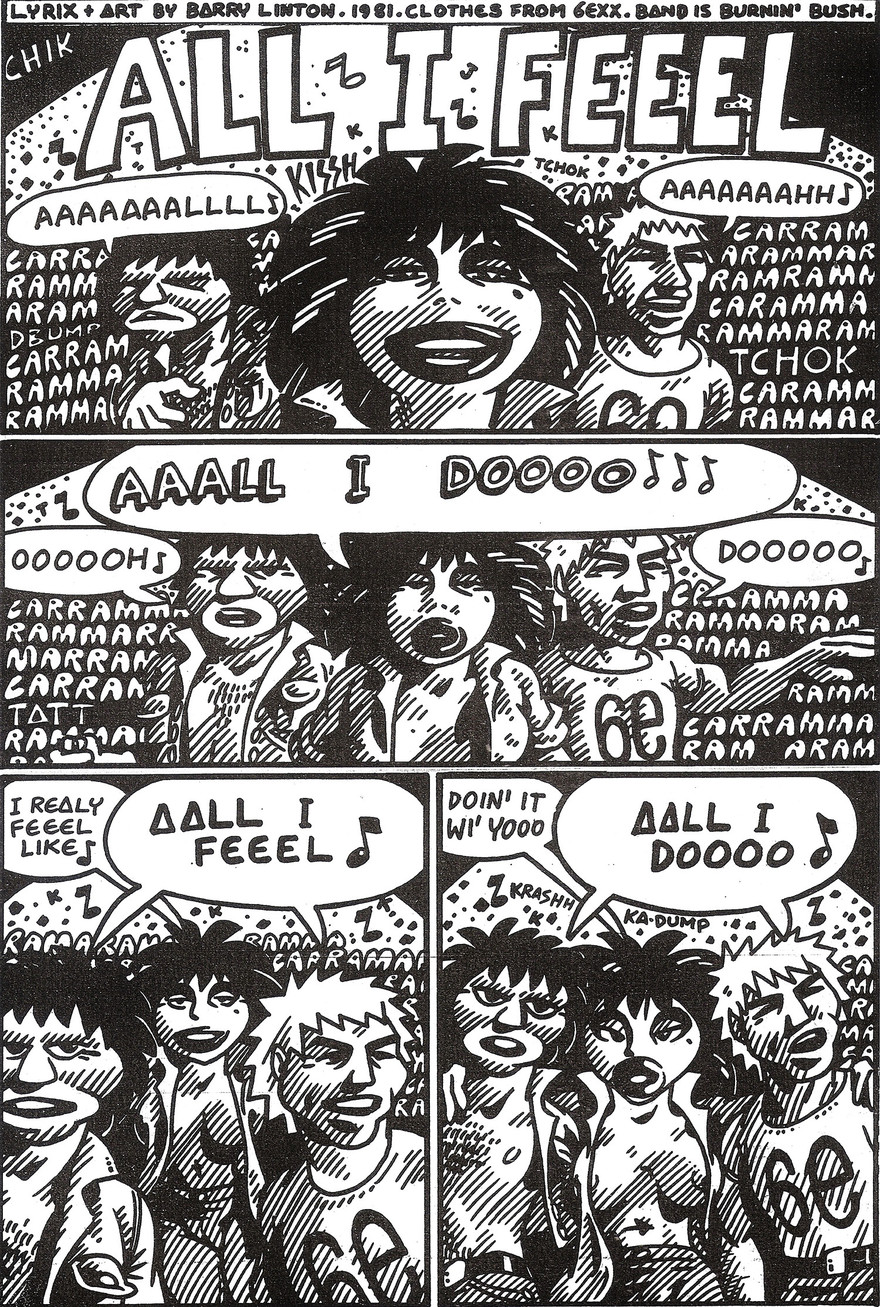
All I Feel, Barry Linton, 1981.
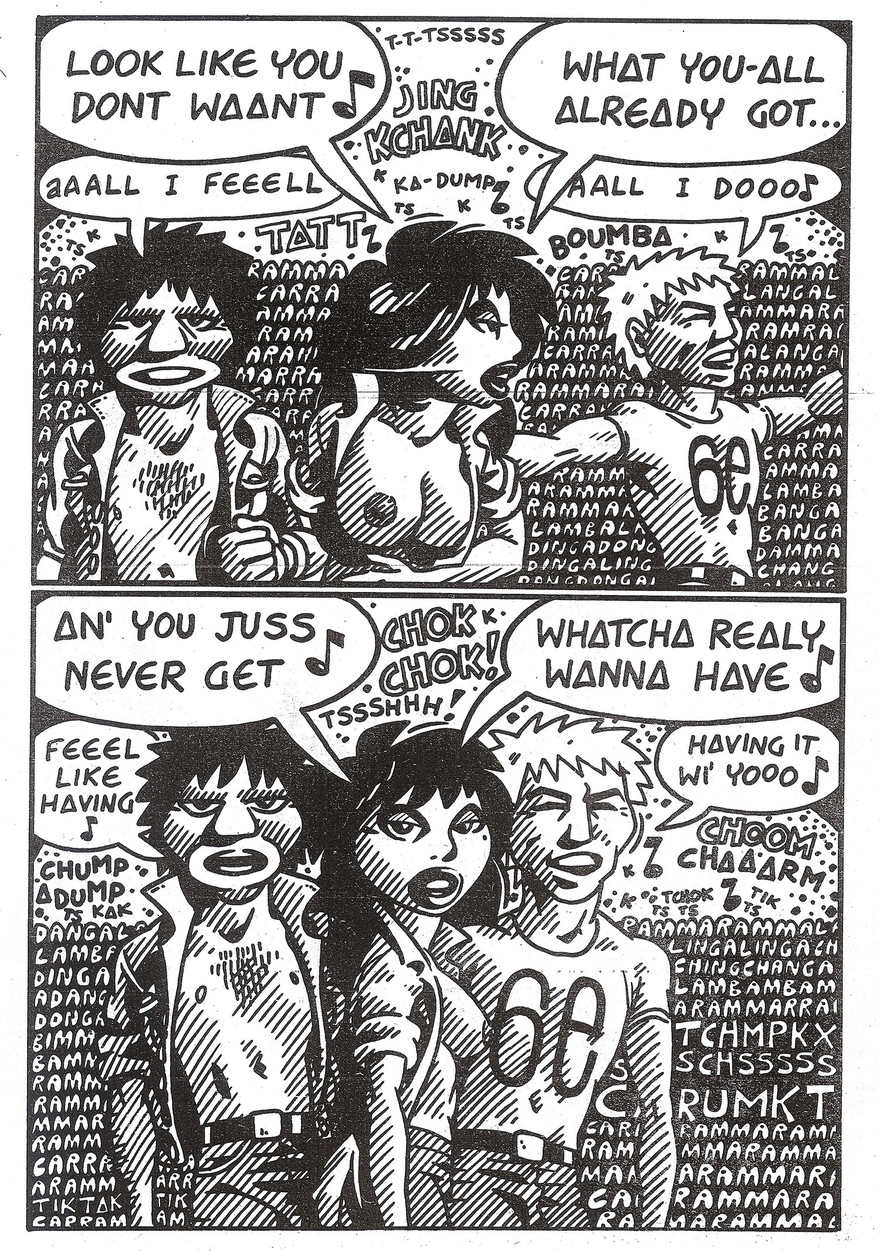
All I Feel, Barry Linton, 1981.

All I Feel, Barry Linton, 1981.
Chris Knox
Chris Knox (The Enemy, Toy Love, Tall Dwarfs) is one of those gifted talents who seems to be five artists simultaneously: a musician, a painter, a film-maker, a writer and a cartoonist. I can’t remember when I first saw one of Chris’s cartoons but by the early 1980s, I was familiar with his unique artwork such as his famous cover for The Clean’s Boodle, Boodle, Boodle (1981) and his posters and album cover art for his own band, Tall Dwarfs. Many of the early comic books produced by local artists who’d been inspired by the US underground scene were not only self-published but self-photocopied – with extremely limited runs. Chris was one of the first to publish a comic which was not only professionally printed but also had a colour cover! His Jesus on a Stick comic featured not only his own work but that of other musician/cartoonists/artists such as Fane Flaws and David Mitchell (The 3Ds, Ghost Club, The Exploding Budgies, Goblin Mix). The first of four issues was published in 1986, then – like many small unsubsidised local publications – it was forced to admit commercial defeat. Despite this, Chris Knox has been a big influence on many local cartoonists. If he liked something it was automatically cool, and in the days before everyone had a computer he has to be given credit for encouraging many of his contemporaries to become artists of one sort or another.
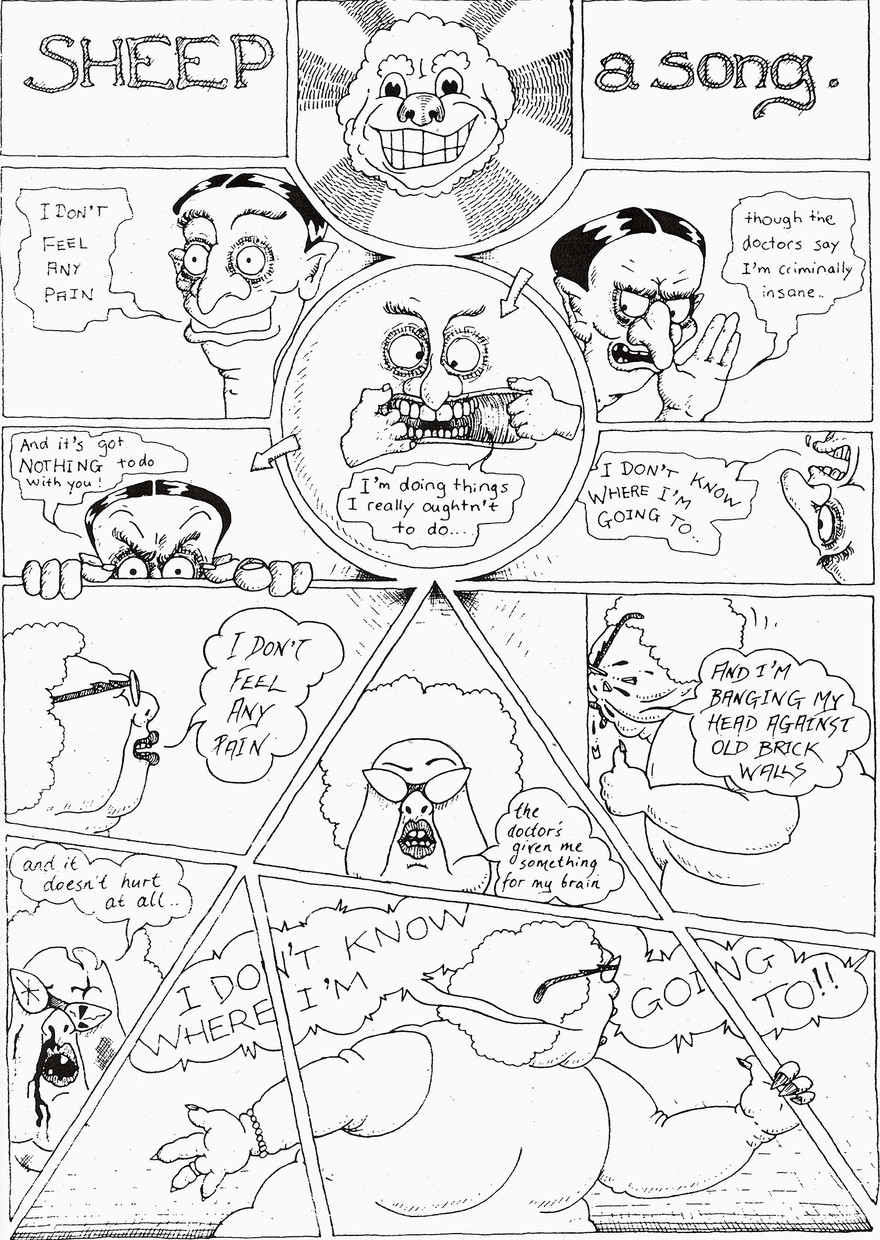
Sheep, Chris Knox - Strips #16, the rock issue.
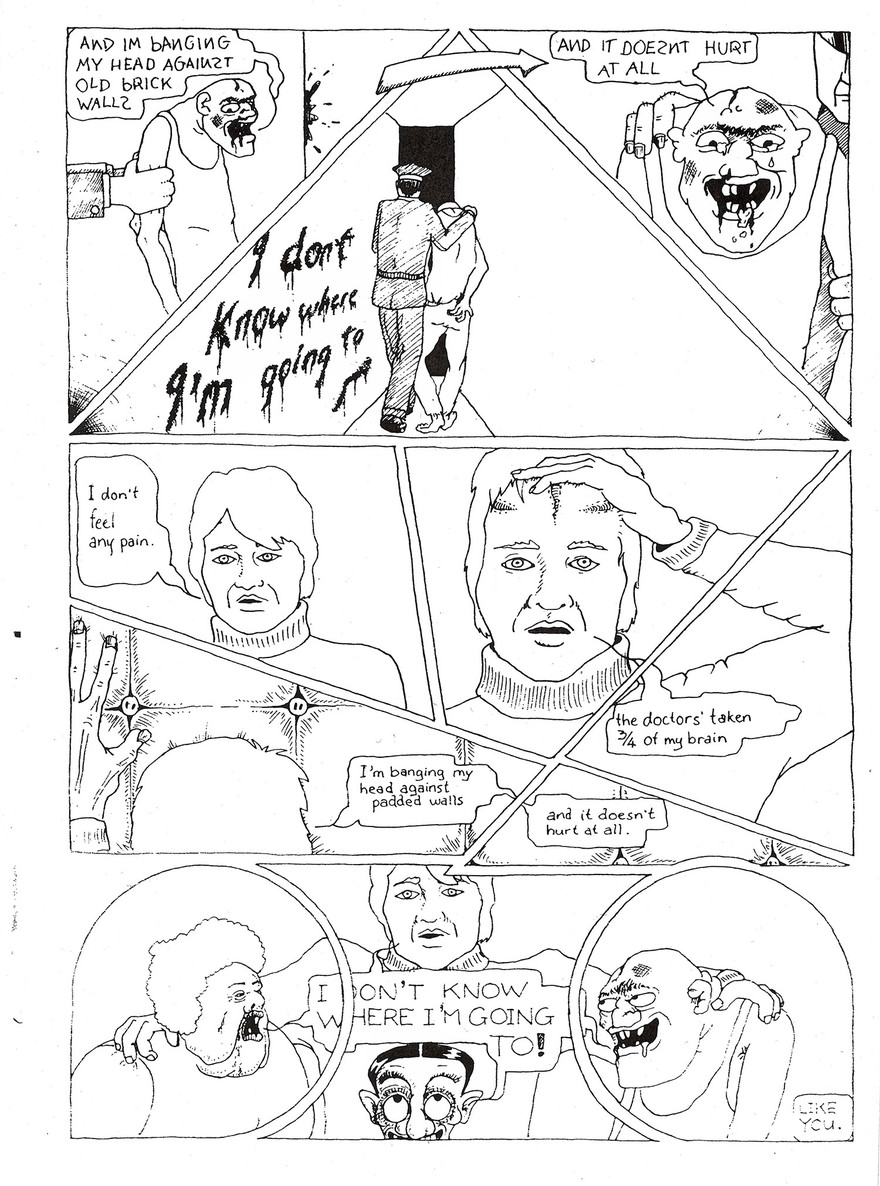
Sheep, Chris Knox - Strips #16, the rock issue.
Robert Scott
Another well-known musician/cartoonist was Robert Scott (The Clean, The Bats, The Weeds, Electric Blood, etc), who is still a prolific artist although he no longer draws cartoons. In 1983 Robert started his own magazine (they weren’t called zines yet) called Every Secret Thing (1983-1987) which also had its own independent cassette label. EST was a mixture of new album and live concert reviews as well as stories and cartoons, many of them by Robert himself but some by other contributors. Despite the small production run for each of the 13 issues it was eagerly looked forward to by its readers. My favourite strip was called The Weeds: the main characters were an endearingly optimistic local band who were travelling the local circuit trying to get famous. Later Robert even started a band with this name and produced a tape featuring all of the fictional bands who were in The Weeds strips. Together with Toby Morris’s strips about The Datsuns, these cartoons really evoke what it was like to be in a New Zealand band of the period.
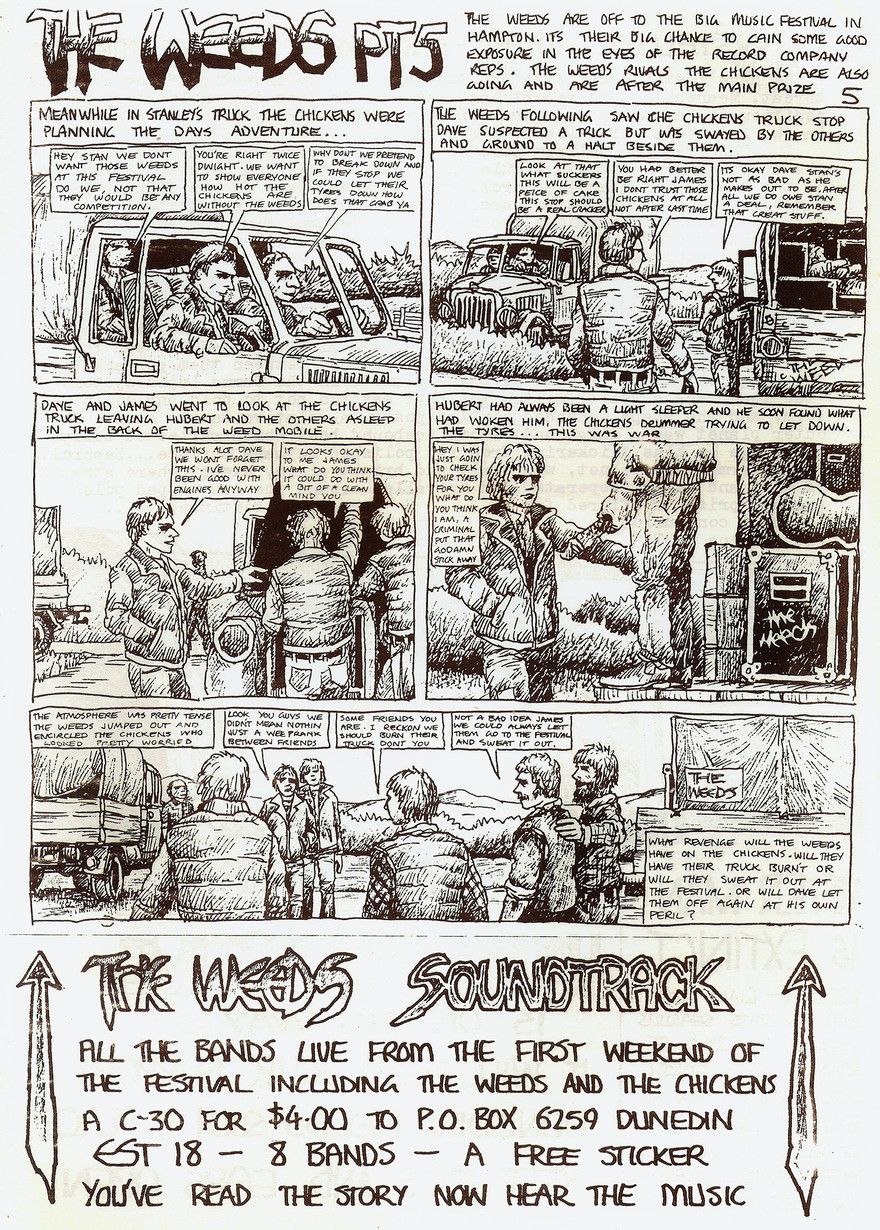
The Weeds part five - Robert Scott, 1986
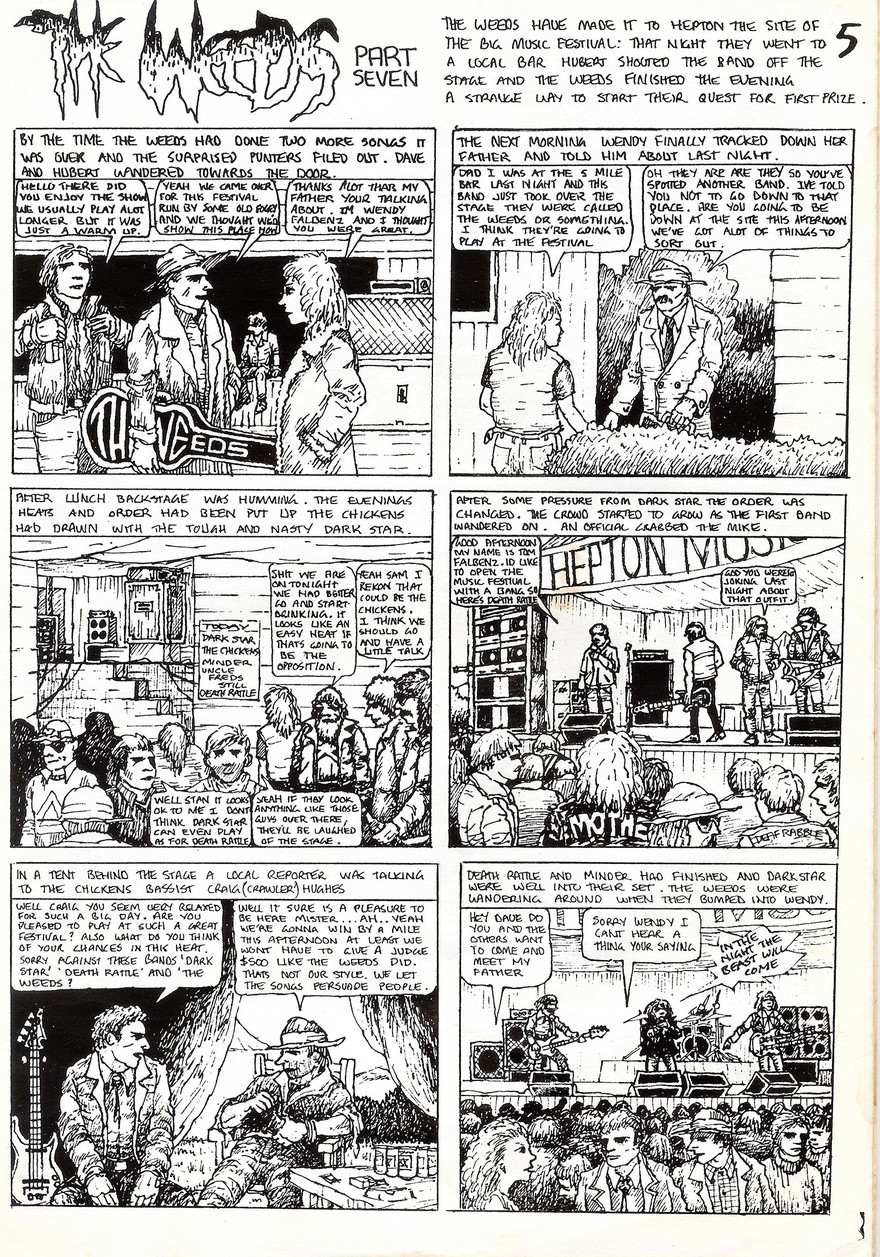
The Weeds part seven. - Robert Scott, 1986
Ian Dalziel
I met Ian Dalziel when he was working at Rip It Up magazine but before that, he had achieved a certain notoriety as the skinniest roadie in the country (for bands such as The Basket Cases and later Toy Love). Ian was a contributor to the free mini-comic that came with The Clean’s Boodle Boodle Boodle EP and the Chris Knox edited “Rock Issue” of Strips. After Rip It Up he worked as a proofreader at The Press and mostly since then he has been a self-employed graphic artist in Christchurch. Ian didn’t draw a lot of cartoons but he let a lot of people borrow comics from his big collection and there’s no doubt he turned a lot of people on to the medium.

Clone Bands, Ian Dalziel - Strips #16, the rock issue.
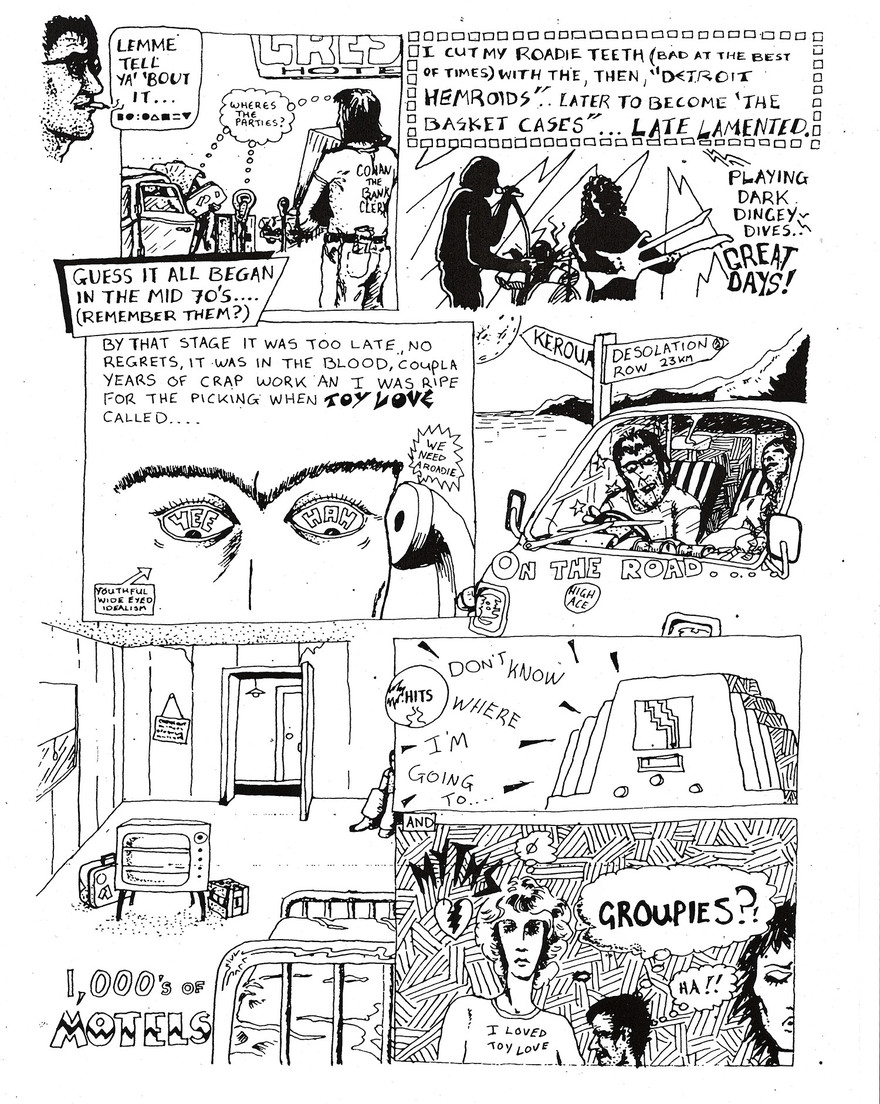
Clone Bands, Ian Dalziel - Strips #16, the rock issue.

Clone Bands, Ian Dalziel - Strips #16, the rock issue..
Toby Morris
Toby Morris was in his teens when he discovered the journalistic/documentary cartoons and graphic novels of Joe Sacco and he was only 20 when his first strip went over big. It was about one of his favourite bands, The Datsuns. The story was originally printed in Victoria University’s Salient magazine in 2002 before it was picked up by the English music magazine Q and – even more amazingly – by Air New Zealand’s in-flight magazine. Toby is the creator of The Pencilsword cartoon strip and, with Toby Manhire, was half of the Toby and Toby duo on RNZ’s website. He also does regular non-fiction comics for the Auckland-based website, The Spinoff.
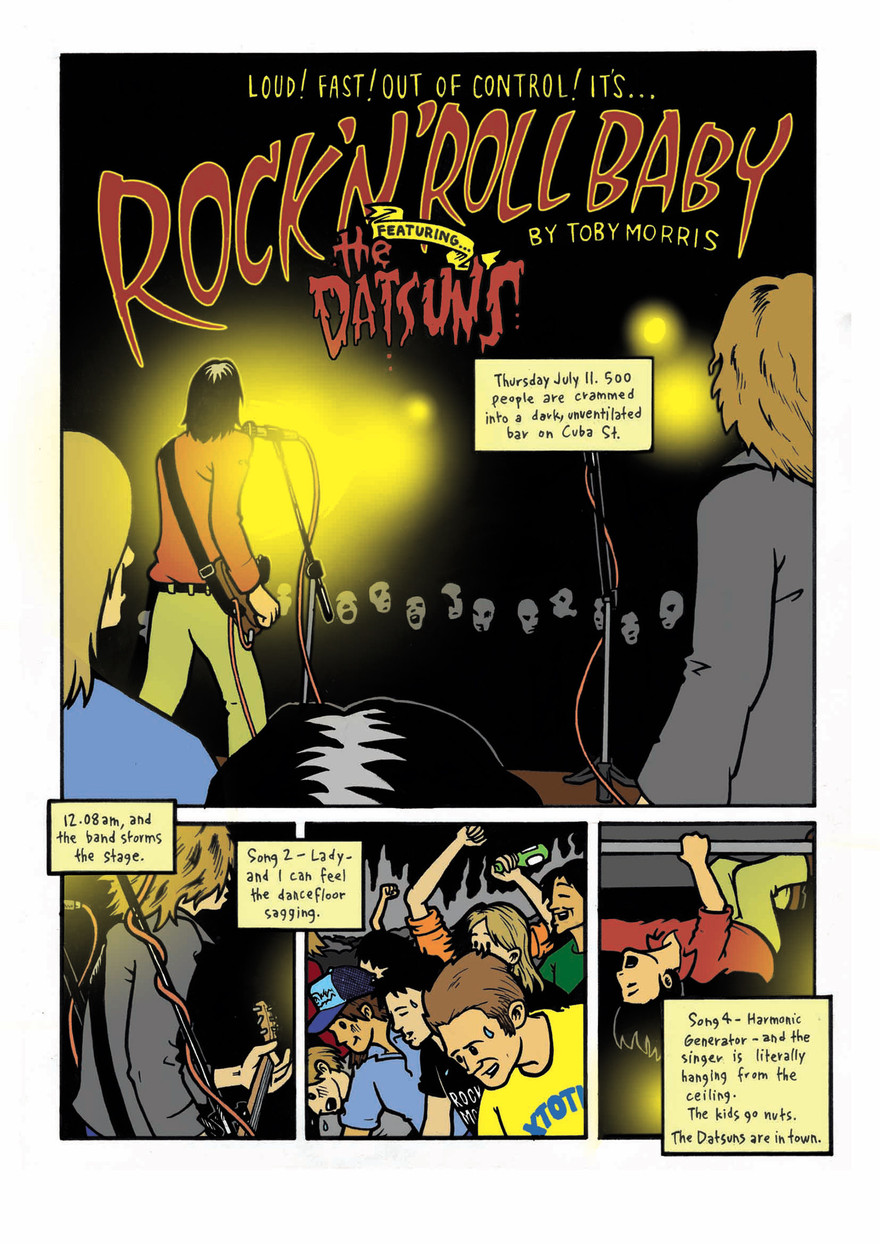
The Datsuns, Toby Morris, 2002.

The Datsuns, Toby Morris, 2002.
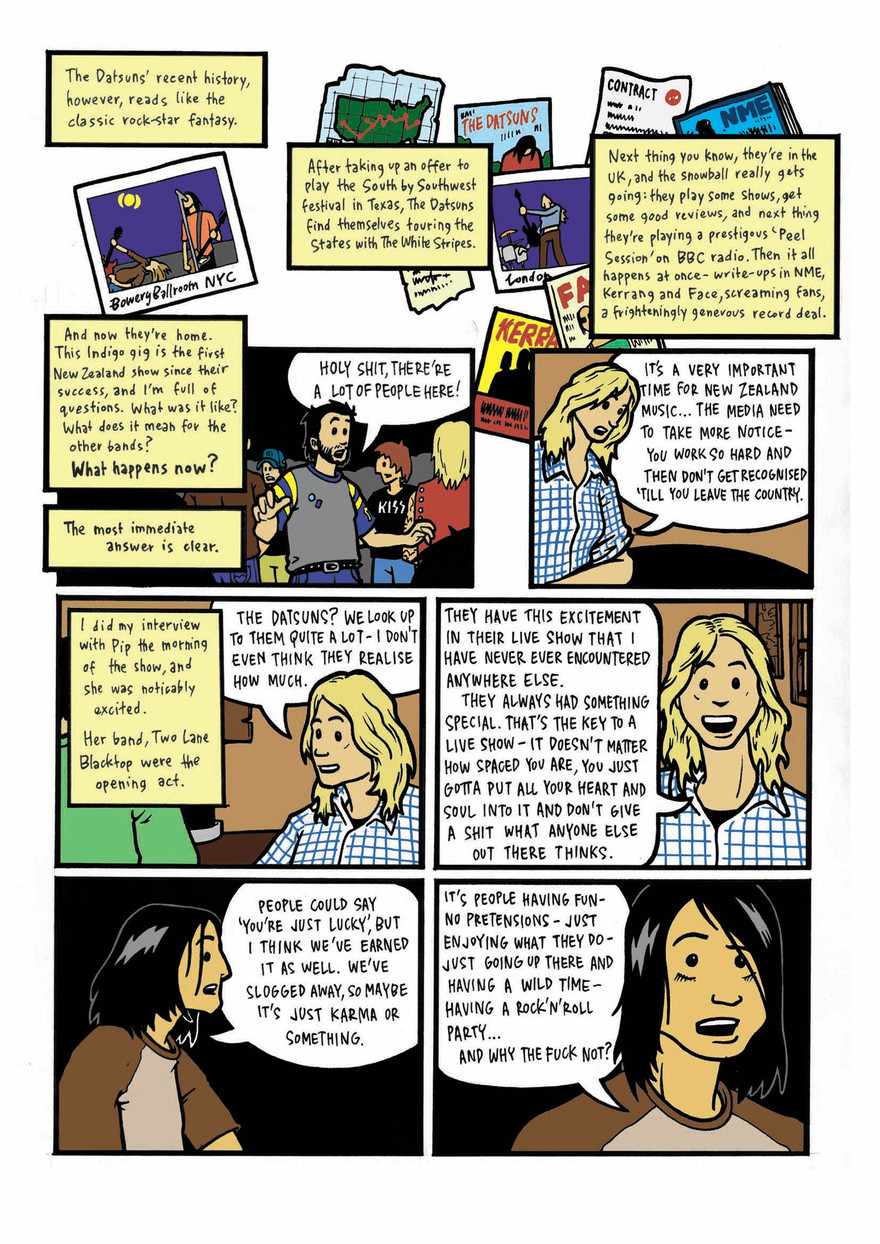
The Datsuns, Toby Morris, 2002.
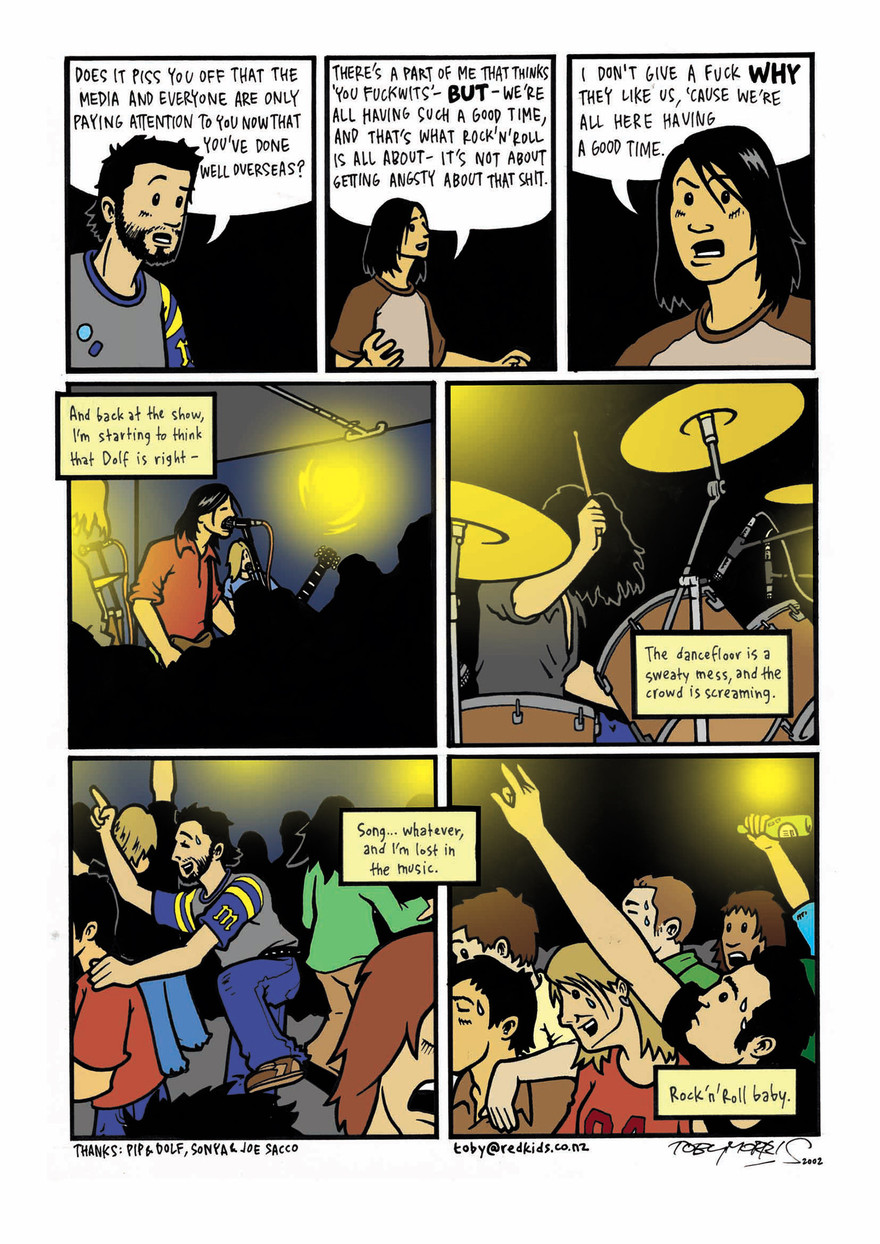
The Datsuns, Toby Morris, 2002.
Ant Sang
Ant Sang is an award-winning cartoonist, based in Auckland. He is the author and illustrator of the celebrated graphic novels The Dharma Punks and Shaolin Burning and was also the designer on the animated TV show, Bro’Town. The pages included here are a scene from The Dharma Punks that was also published in Filth mini-comics. Sometime in the 1990s Chopstick, the protagonist, experiences a moment of spiritual enlightenment in the middle of a Loves Ugly Children gig. Ant is currently a lecturer at MIT, where he teaches comics and graphic novels – and he is working on his own new graphic novel.
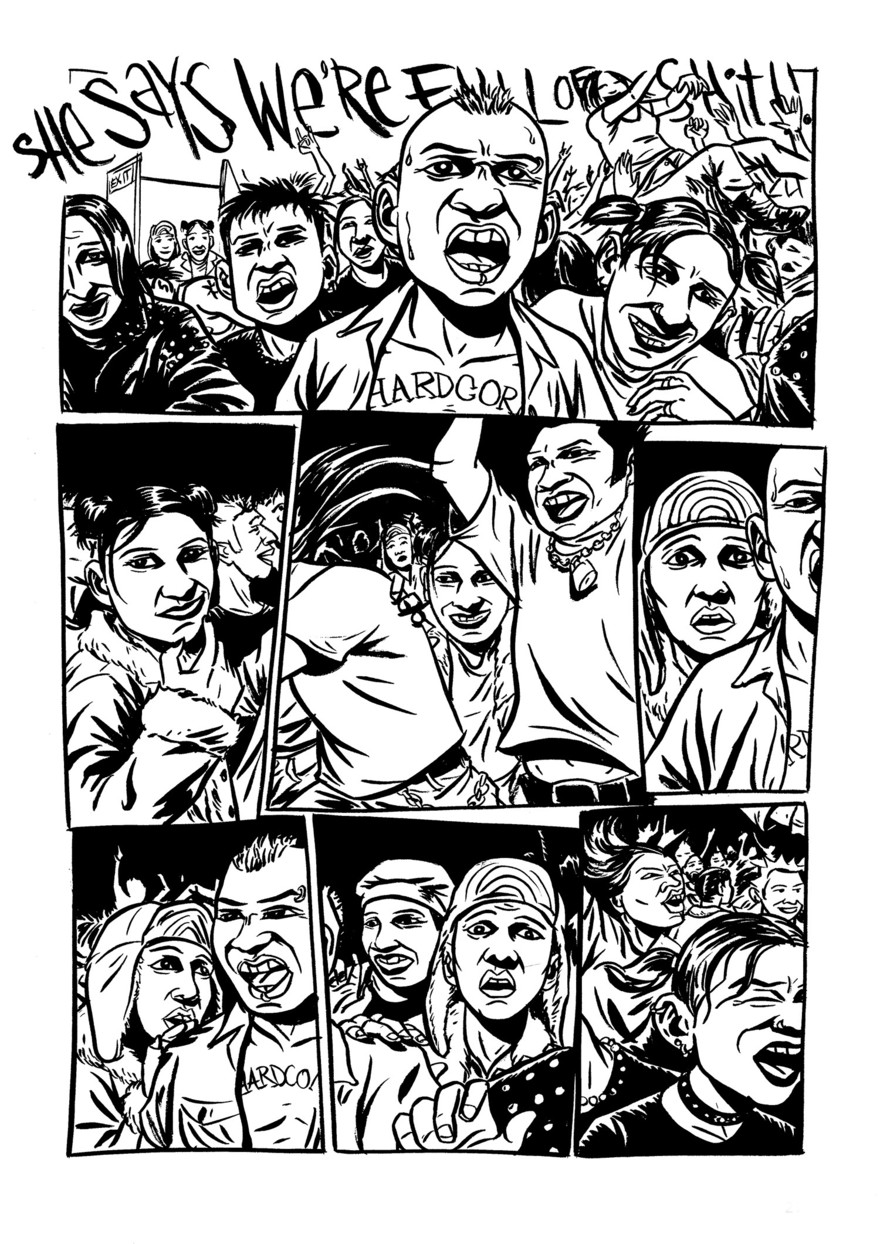
Dharma Punks, Ant Sang.
Stefan Neville
Stefan Neville hasn’t done any comics about bands he’s been in himself (eg Pumice, Teen X-Ray) but like many of the contributors, he feels that the two worlds are (or were then) inextricably intertwined. Stefan moved to Hamilton in the early 1990s and started collaborating with Clayton Noone and others as part of Oats Comics collective (as well as playing in bands of course). Their City of Tales comics have been compiled into three books, What The Fuck Is A Free Radical, Identity Cleared Of Beard Ripping and Win Tane’s Bra. Neither of them are currently producing cartoons but they’re still active in bands.
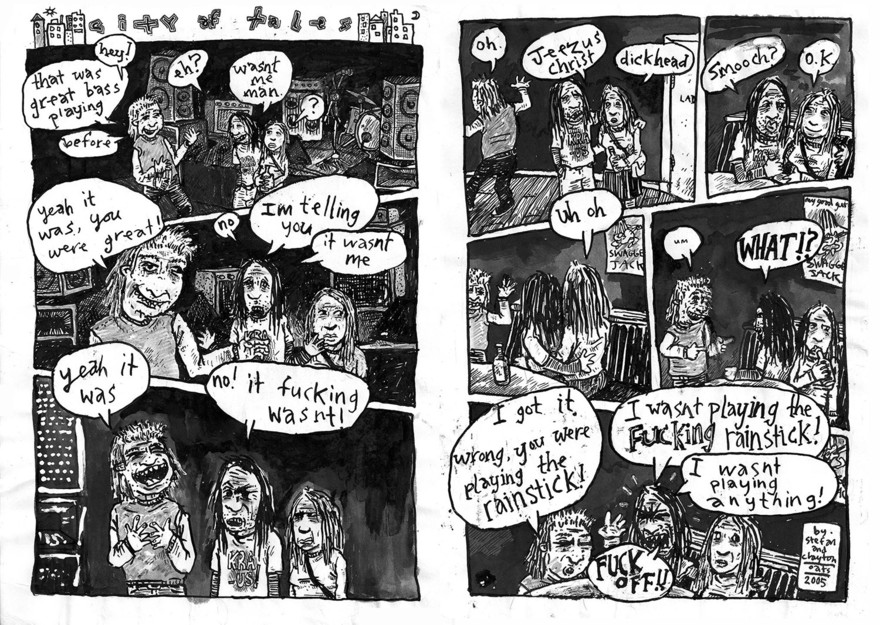
City of Tales, Stefan Neville and Clayton Noone.
Indira Neville
Stefan’s sister is also a cartoonist who has been drawing compulsively and self-publishing zines – as well as occasionally appearing in mainstream publications – for over 20 years. In 2016, with Sarah Laing and Rae Joyce, she co-edited Three Words, a comprehensive anthology of New Zealand women’s comics. Published by Beatnik, it featured 60 women comic creators. She also co-edited the anthology, Sonic Comic, a collection of individual works that have both comic and sonic components. When she’s not drawing or editing Indira plays with noise-pop band The Biscuits and an electronica duo called Drop Zone.
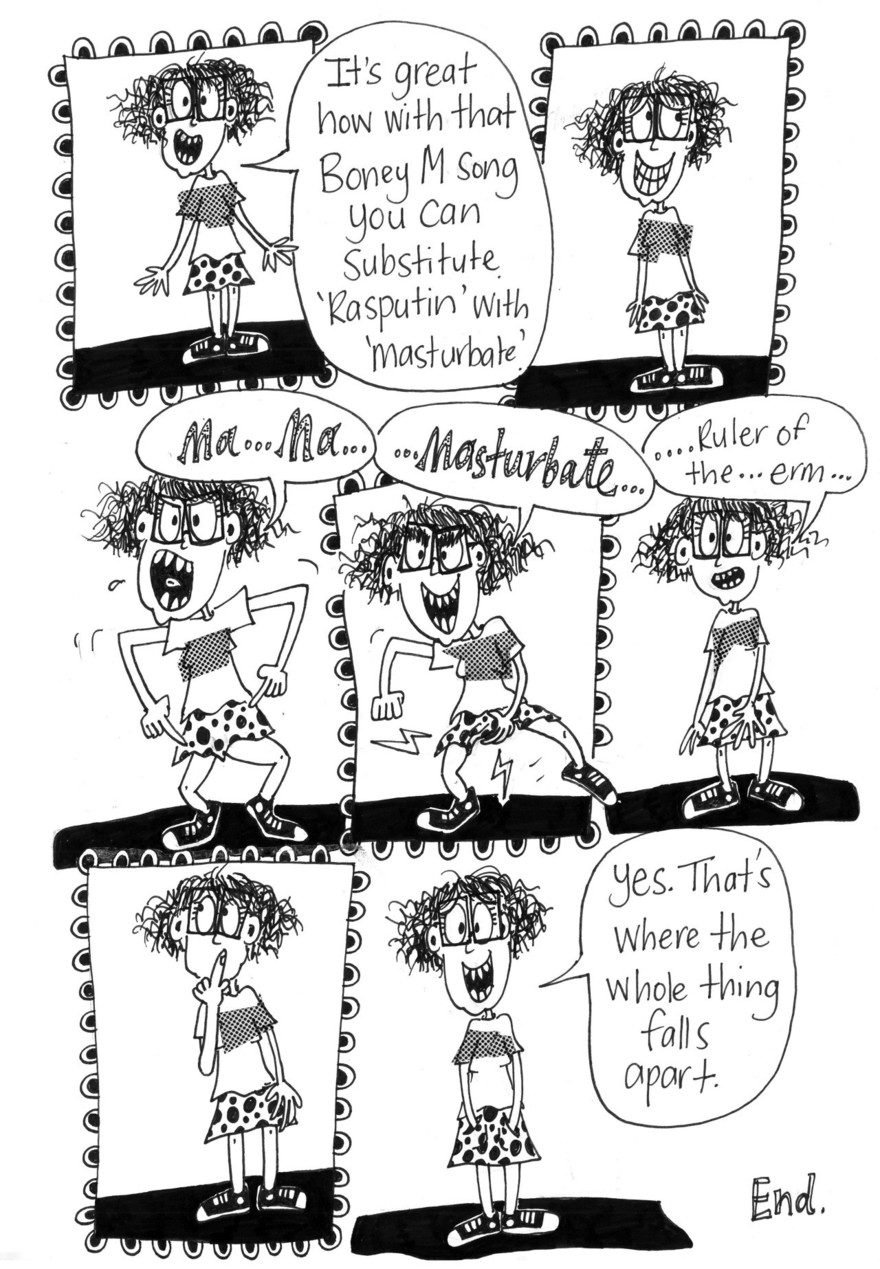
Rasputin, Indira Neville.
Sarah Laing
Another cartoonist who has been inspired by the local music scene is Sarah Laing, a writer and illustrator based in Wellington. Her graphic memoir Mansfield and Me was published by VUP in New Zealand, and Lightning Books in the UK. Like many cartoonists, Sarah grew up a big Tintin and Asterix fan, and also loved Calvin & Hobbes when it first hit New Zealand. Currently, Sarah is working on a post-climate change comic book. The Morrissey strip included here is a true story.

Sarah Laing almost meets Morrissey, Dec 2012.
Bruce Mahalski
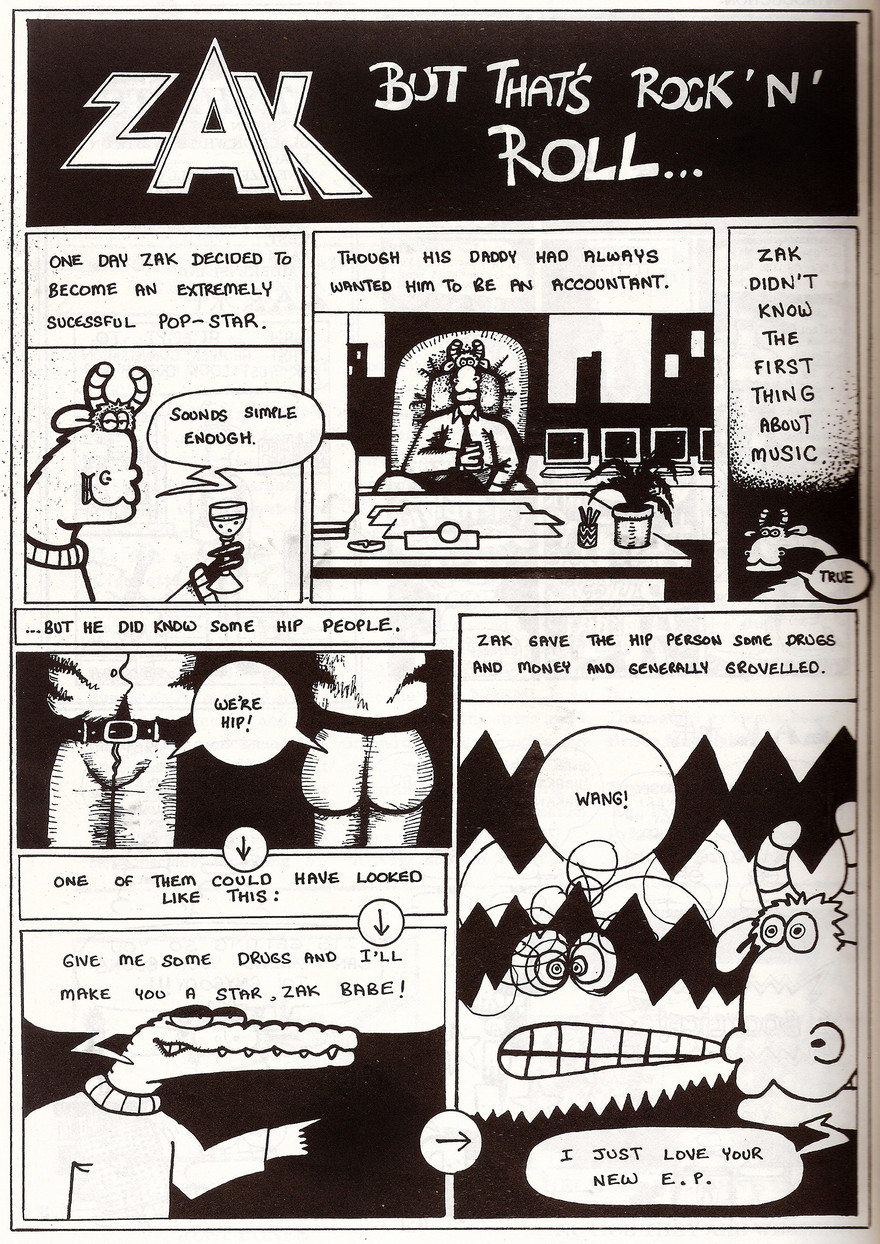
Zak Gets Hip, 1985, Bruce Mahalski.
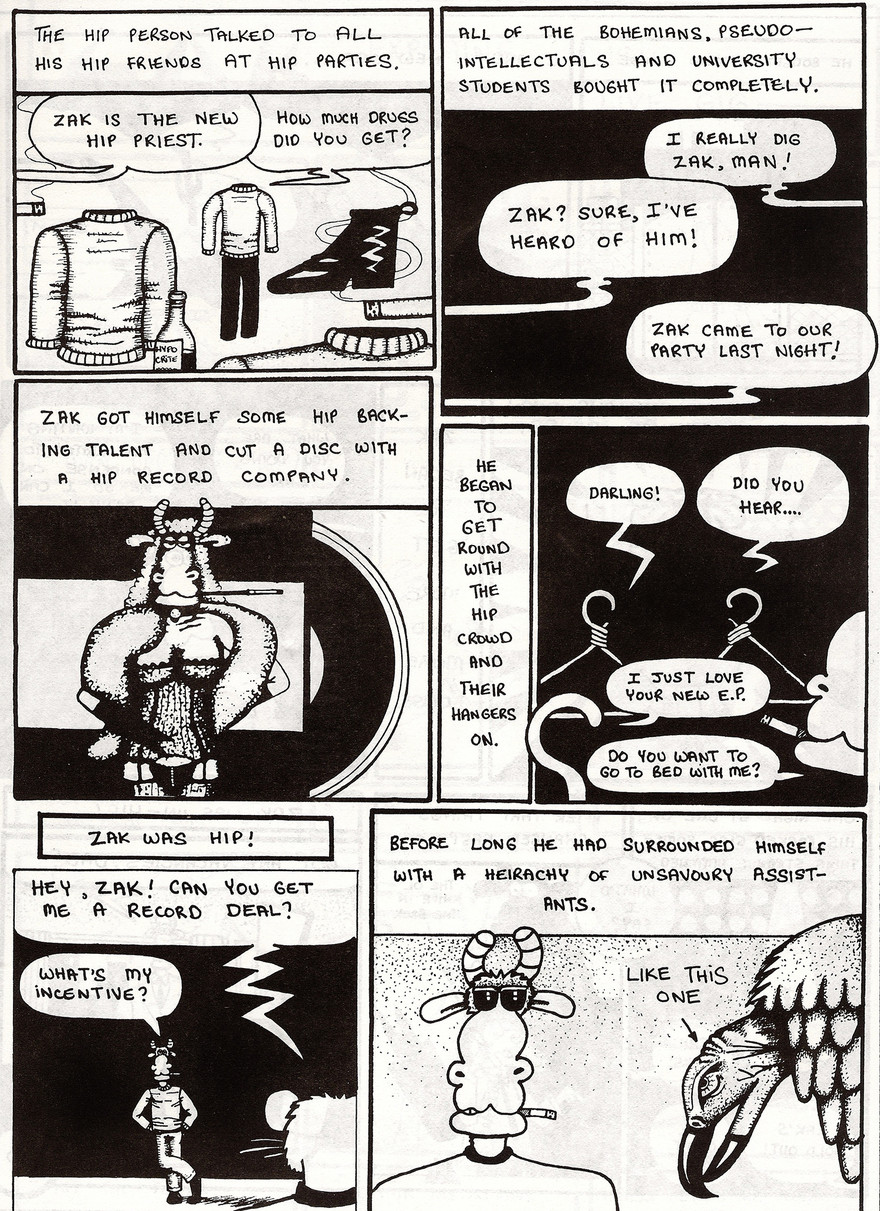
Zak Gets Hip, 1985, Bruce Mahalski.
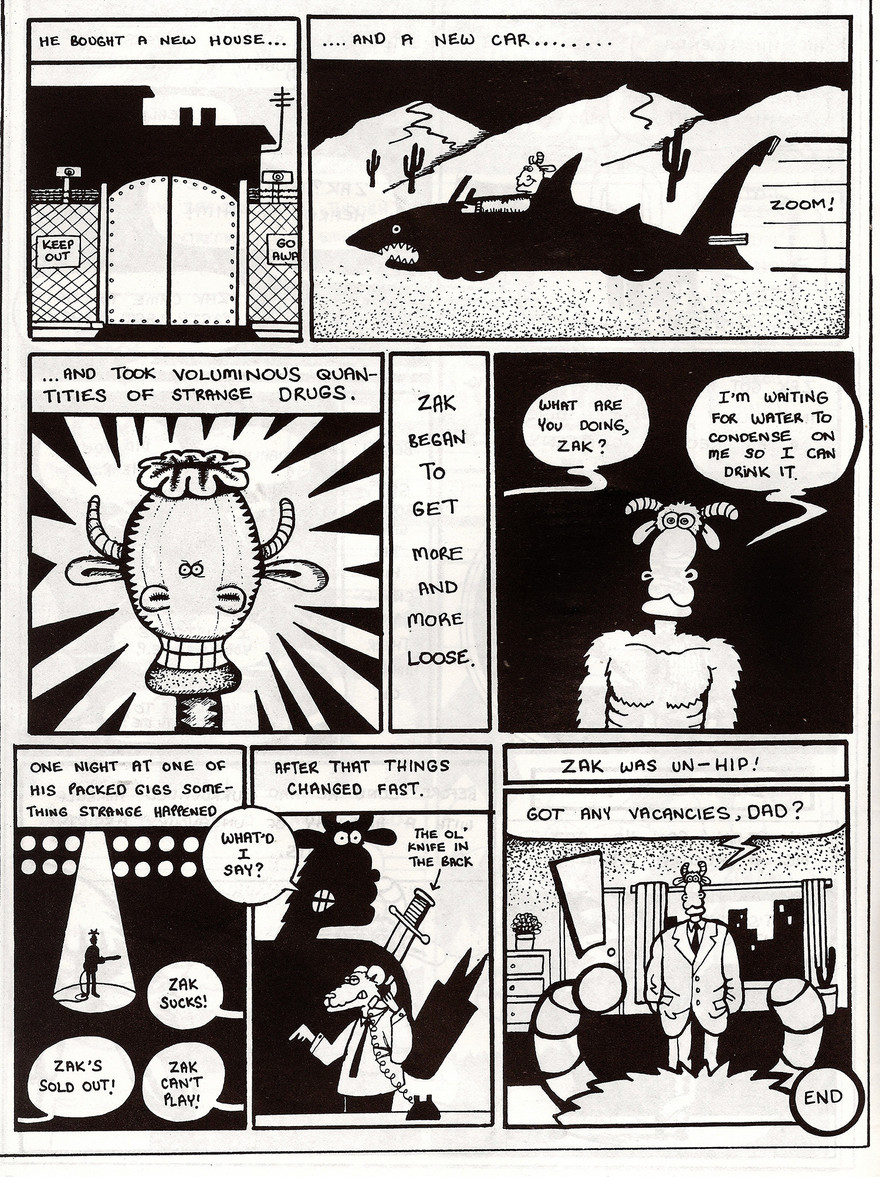
Zak Gets Hip, 1985, Bruce Mahalski.